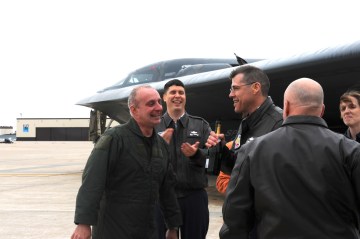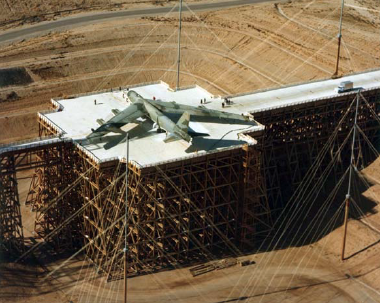The Minuteman missile is the lone type of ICBM remaining in the nation's nuclear triad, and the leg most vulnerable to being eliminated.
President Obama’s call this week to cut the U.S. and Russian nuclear arsenals by one-third has a certain symmetry to it, given the fact that if war broke out between them, the U.S. would use three different kinds of weapons to rain atomic fire down on the Russians: bombers, land-based missiles, and submarine-launched missiles.
More than 20 years after the Cold War, that’s the way it’s going to stay, according to Defense Secretary Chuck Hagel.
“The United States will pursue negotiated reductions with Russia,” Hagel said Wednesday in a speech at the University of Nebraska – his alma mater – in Omaha, also the home of the U.S. Strategic Command, which oversees the nation’s strategic nuclear forces. “As we pursue these reductions, let me emphasize three things — three things that will not change. First, the U.S. will maintain a ready and credible deterrent. Second, we will retain a triad of bombers, ICBMs (intercontinental ballistic missiles), and ballistic missile submarines. Third, we will make sure that our nuclear weapons remain safe, secure, ready and effective.”
We will retain a triad of bombers, ICBMs, and ballistic missile submarines.
Why?
The nuclear triad is a creation of the Cold War, when the U.S. and Soviet Union were busy building nuclear bombs to destroy one another. Each concluded that having three separate systems to deliver those weapons was key to deterrence. It meant that a surprise attack on the other side’s nuclear forces would be complicated to the point of futility.
But the Cold War is over, and debate over the U.S. triad has heated up because all three of its legs need to be modernized: new bombers and submarines costing perhaps $100 billion or more are on the drawing boards, and the Air Force is spending $7 billion to update its Minuteman missiles, with plans to replace them after 2030. And just what potential foe out there has the means – never mind the desire — to wipe out even a single leg of the U.S. nuclear force?
With the Pentagon budget in decline, amputating a leg of the triad would surely save money. But the dollars are tough to nail down, and spread among hundreds of U.S. government accounts. Figuring out precisely how much might be saved is challenging: triad boosters tend to minimize the cost ($10 billion annually to operate!), while those eager to jettison nuclear weapons tend to maximize them (more like $56 billion when you include the cost of replacing the aging systems used to actually deliver them!). It’s a safe bet the truth is somewhere in-between.

Then-Brig. Gen. Garrett Harencak, left, celebrates his end-of-tour B-2 flight in 2009 as he gives up command of the 509th Bomb Wing at Whiteman Air Force Base, Mo.
Major General Garrett Harencak, the assistant Air Force chief of staff for strategic deterrence and nuclear integration, says operating the current triad costs Americans less than they spend on going to the movies every year — only 2% of the military budget, about $10 billion annually. “We’re not spending a lot of money on it,” he said earlier this month, “and what we are [spending] is certainly a bargain.”
The triad, he added, isn’t some Cold War hangover, as some critics assert. “We in no way — in no way — have anywhere near the structure or even the mindset that we had in the Cold War,” the two-star general and 30-year bomber pilot said. He then explained what he said a Cold War mindset really looks like:
I used to command at Kirtland Air Force Base in Albuquerque. And if you ever get a chance to go there, you’ll see the world’s largest laminated wood structure ever built, OK? It’s the EMP trestle there, if you’ve ever seen that. That was a $60 million project, started in 1970, ended up costing about $200 million. There really was no debate about it. It was just done. We as a nation built a spur of a railroad to bring specially designed railroad cars that we had designed and built. We took essentially a small area of a forest in Washington state, declared it a national security site so we could get these laminated wood structures.

A B-52 atop the EMP Trestle, where the Pentagon tested U.S. aircraft to see how they would fare amid nuclear war.
But that was then. Now, the threat is less atomic, and more economic.
Last year the anti-nuclear Ploughshares Fund estimated the U.S. government will spend about $640 billion on nuclear weapons and related programs over the coming 10 years. Retired Marine general James “Hoss” Cartwright, who left the military in 2011 as vice chairman of the Joint Chiefs of Staff, has called for eliminating the land-based missile leg of the triad and additional cuts in the deployed force. The non-profit Global Zero group, to which Cartwright belongs, has estimated that could save $100 billion over a decade.
“The time has most definitely come to end the land-based portion of the triad,” says Thomas P.M. Barnett, a former Pentagon strategist. Conveniently, he notes, slicing off the triad’s ICBM leg would leave “in the two surviving legs” the Air Force’s beloved bombers and the Navy’s cherished submarines. “This is a question of identity for both services,” Barnett says. “Land-based missiles are bureaucratic `orphans’ of a sort, claimed primarily now by the missile-defense crowd.”
Yet whatever the savings or rationale, Harencak, the Air Force general, made clear over that June 7 breakfast that he doesn’t think the push to eliminate nuclear weapons is worth it:
Now, personally, if you ask me, I think it’s going to be a long time before we, as a world community, all get together in a nice room like this, have eggs and sausages and potatoes and say, “Hey, you know, what? Probably, I’ve got a better idea to resolve our differences: why don’t we just talk them out? And at the end, we give each other a good hug, OK?”
I hope that day comes. I hope that day comes soon. And when it does, I want to invite you all over to my house for a party. No, seriously, because I think that’d be cool. I like to have parties; I want you all to come over. Because when that happens, where we can get rid of these weapons within, you know, soon, we’ll have a big party at my house. I think it’ll kind of be cool, you know, as a nuclear guy and everything else, we’ll have a big party.
I just ask that you don’t feed any hors d’oeuvres to my unicorn, all right? Because he makes a mess in the yard.


